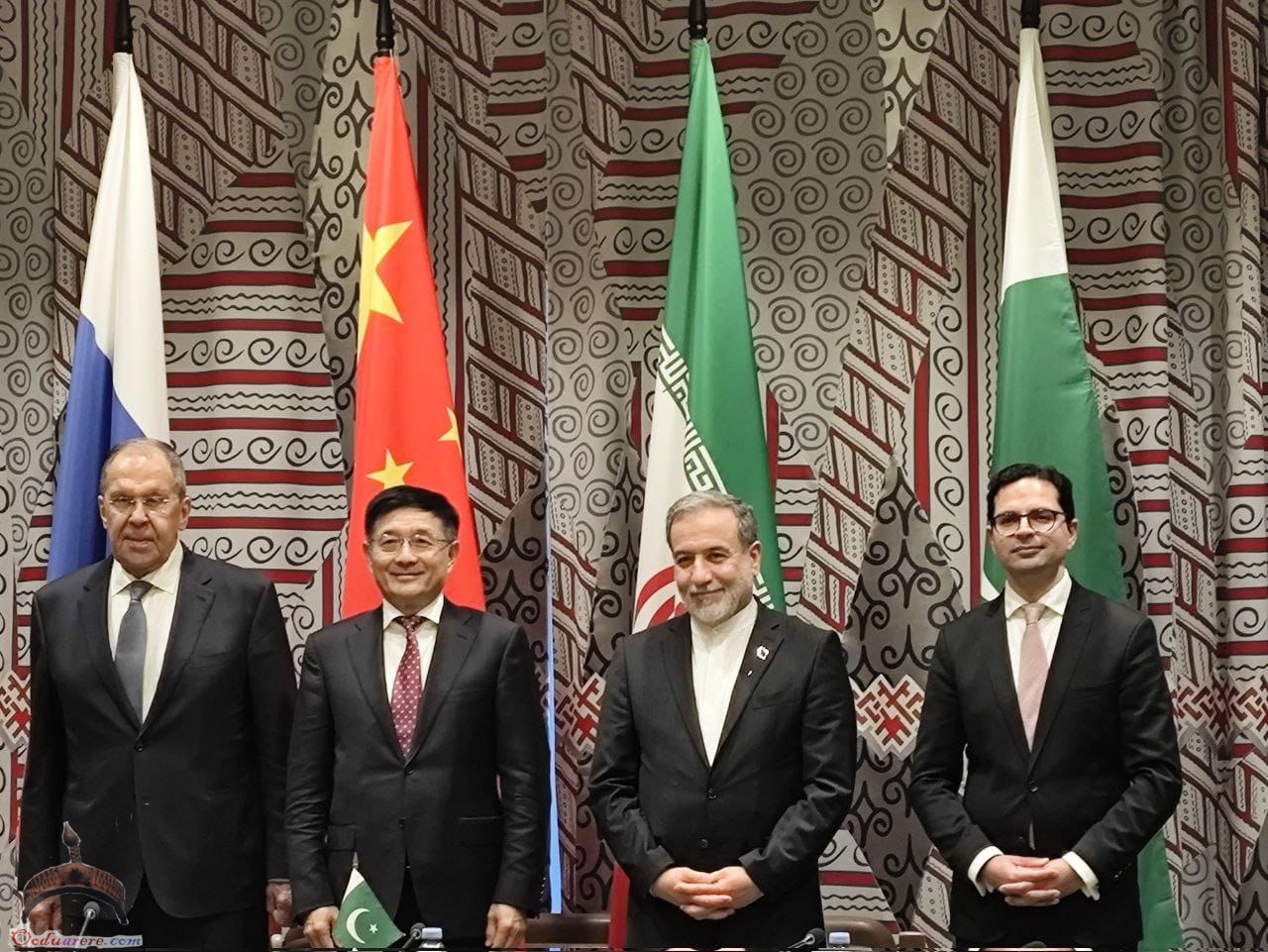By Aram Mirzaei
“They say we are a nation of tears, but with these tears we have overthrown an empire” – Imam Ruhollah Khomeini.
As the Iranian people are celebrating the 38th anniversary of the establishment of the Islamic Republic, Washington has recently installed its 7th president since that cold winter day of February 11, 1979. To many Iranians, the Islamic Revolution represented a defining moment in Iranian history, one where an entire nation released itself from the clutches of Washington and its puppet despot Mohammad Reza Pahlavi. This was the final time foreigners had the privilege to dictate the lives and destinies of Iranians.
Just like almost all revolutions in the past, the Islamic Revolution was hardly welcomed by foreign actors, who immediately plunged the country into a brutal eight long war with neighbouring Iraq in order to curb the newly established Revolutionary government. While the French, Russian and Chinese revolutions were marked by a radical departure from their respective historical pasts, the Islamic Revolution instead went back to the roots of the country, unifying five centuries of inseparable affiliation between Iran and Shia Islam. This unity between state and religion is still not accepted nor is it understood by the West.
As mentioned above, the Islamic Republic is the result of five centuries of affiliation between the people and Shia Islam. Ever since the days of the Safavid dynasty (1501-1736), Iranians have adhered to the Twelver branch of Shia Islam. The Safavids ruled Iran as a theocracy back then as well, with the powerful Ulema (clerical establishment) by their sides. This form of rule prevailed in Iran until the rule of the Qajar dynasty which came increasingly under the foreign influences of the Russian and British empires. From that era onwards, the Ulema became a strong source of opposition to the Royal Courts and were viewed increasingly as champions of the oppressed people of Iran.
Western pundits and politicians only understand Iran from a perspective of their own experiences and teachings, this makes Iran in their eyes a “theocratic dictatorship under the ruling of a clerical establishment”. What the Western policy makers and pundits have failed to understand is that their conception of secular rule is one that is hardly preferred by the oppressed people of the Middle East, as the people of the region first and foremost care about their own security amid all the conflicts that have been engulfing the region for the better part of the past two centuries. Another factor to take into account is that the Iranian people have seen what a Western style secular rule, approved by Washington is all about, it is the core reason as to why they even overthrew the Pahlavi regime from the first place.
For Iran, the experiment of secular rule began with the Pahlavi regime when Reza Pahlavi assumed power in 1925 and continued through his son, Mohammad Reza Pahlavi’s rule. Throughout these 54 years, they ruled Iran through a policy of Westernization in a bid to modernize the country. What both father and son Pahlavi failed to comprehend was the fact that any kind of modernization of a country must come from the people below rather than being the product of a foreign custom and culture, imported from a part of the world that has no ties to the country itself. Throughout their reigns, they both tried to culturally reform the country while failing to address the massive socio-economic issues, thus they managed to alienate the people as the Royal Court instead became more and more viewed as a distant palace of foreign decadence.
So, when both Shahs for example, attempted to implement Western dress codes as mandatory for all Iranians, instead of gaining the support they hoped for, they managed to turn the powerful Ulema against themselves.
Iranians tried to experiment with the concept of Western democracy in 1952-53, however Washington and its British allies, the so-called leaders of the free world would not allow this to happen. The elected Prime Minister Mohammad Mossadegh was overthrown in a CIA backed coup codenamed Operation Ajax in order to reinstate Mohammad Reza Pahlavi as Shah of Iran. What convinced the US and the UK to overthrow Mohammad Mossadegh was the was the nationalization of the Iranian oil industry, which had been under British control since 1913 through the Anglo-Persian Oil Company.
The coup d’état was seen as a humiliation for many Iranians who finally came to understand that the Western powers are only interested in exploiting Iran for its vast natural resources and its geostrategic value. When the Pahlavi regime was finally overthrown by popular demand, US-Iranian relations went from amicable to abysmal and ever since then, Washington and its vassals worldwide have been on a rampant spree of spreading Iranophobia in order to isolate and contain Iran, to little success. The Islamic Republic still stands tall despite economic sanctions since 1979, support for Saddam with weapons and intelligence in his murderous 8-year-long war, several attempts at “velvet revolutions”, acts of terrorism and direct threats of war based on false accusations of Iran’s alleged nuclear weapons program which has involved a massive demonization campaign aimed at spreading Iranophobia across the International community. As a matter of fact, despite the best attempts of the West to isolate Iran, the Islamic Republic is today recognized as a key player in the region, with some powerful allies backing it. Washington is fully aware of this fact and was thus forced to the negotiating table to carve out a nuclear deal with its enemy, despite the vocal objections of its key ally Israel.
Looking at Iran’s role in the Iraqi and Syrian crises of recent years, Iran has played a pivotal role in upholding these two countries in the face of a massive terrorist threat, sponsored and created by Washington and its allies. These regional conflicts which have essentially been ignited to target the Islamic Republic itself, in a bid to contain Iran and protect Israel, by destroying and overthrowing Iran’s allies, have given the Islamic Republic an opportunity to rise to the occasion and assume a moral authority in the face of the International community by leading the fight against terrorism. The Islamic Republic’s choice to join forces with Russia in Syria has not only managed to score numerous victories against terrorist groups rampaging across the country, but also to save the legitimate Syrian government and outmanoeuvre Washington to the point where it no longer has a role to play in the conflict. This itself is a testament to the resilience the Islamic Republic has shown to any kind of animosity directed towards it.
But Iran has also shown defiance in other aspects where it has been the target of harsh punishment for its resistance, for example Iran has advanced dramatically in the area of healthcare since the time of the Islamic Revolution in 1979 and, as a result, not only has life expectancy risen from 55 to over 71, but also infant mortality has fallen over 70 percent despite the draconian sanctions placed on the country. Iran’s health care system, known as Integrated Primary Health Care (IPHC), has been so successful, that doctors in the American state of Mississippi, the state with the highest poverty rates and poorest healthcare outcomes in the U.S., looked to Iran for help in designing a cost-effective healthcare system.[1]
In the military field, the Islamic Republic has managed to develop a defence worthy of mention. Despite lacking the modern sophisticated military equipment its U.S allied neighbors possess, Iran’s military has been described as the Middle East’s “most powerful military force”. [2] On November 2, 2012, Iranian Brigadier General Hassan Seifi reported that the Iranian Armed Forces had achieved self-suffiency in producing military equipment, and that the abilities of Iranian scientists have enabled the country to make significant progress in this field. He was quoted saying, Unlike Western countries which hide their new weapons and munitions from all, the Islamic Republic of Iran’s Army is not afraid of displaying its latest military achievements and all countries must become aware of Iran’s progress in producing weaponry.”
Finally, there is the fact that Iranian women are far ahead of their counterparts in other Persian Gulf nations socially, politically, educationally and health-wise. Governmental policies, again stemming from the principles of the Islamic Revolution, support women by granting them six months paid maternity leave plus an extra hour of paid leave per day for eighteen months, maternity benefits that exceed International Labor Organization standards not to mention those in the U.S. and other Western countries. Furthermore, women constitute about 60 % of all university students in Iran, a figure exceeding those of western countries. Of course, the Western narrative only speaks of the “oppressed Iranian women who are forced to wear the hijab” and never mention these feats.
These positive gains in economic and social development in Iran after the victory of the Islamic Revolution stemmed from maintaining a strong unification of religion, daily life and government, and rigorously shunning the secular concepts of the West.
In the end, every day that the Islamic Republic continues to exist is an act of defiance to the Anglo-Zionist empire as it will continue to lead the struggle against Washington/Tel Aviv sponsored terrorism and geostrategic interests in the region. While the West is in a state of decline, especially on a moral level, people across the world are waking up to see that the Islamic Republic of Iran has never been an enemy of mankind, but rather, it has been leading the fight against imperialism in the Middle East.
As the Islamic Republic enters its 38th year, one can’t but think back to the words of Imam Khomeini: “They say we are a nation of tears, but with these tears we have overthrown an empire”
 Ọmọ Oòduà Naija Gist | News From Nigeria | Entertainment gist Nigeria|Networking|News.. Visit for Nigeria breaking news , Nigerian Movies , Naija music , Jobs In Nigeria , Naija News , Nollywood, Gist and more
Ọmọ Oòduà Naija Gist | News From Nigeria | Entertainment gist Nigeria|Networking|News.. Visit for Nigeria breaking news , Nigerian Movies , Naija music , Jobs In Nigeria , Naija News , Nollywood, Gist and more









